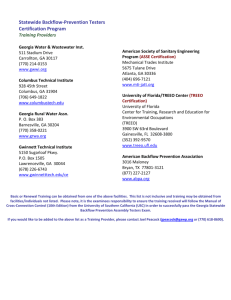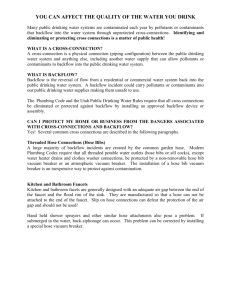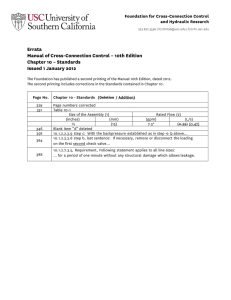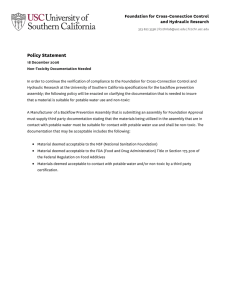Installation AVB
advertisement
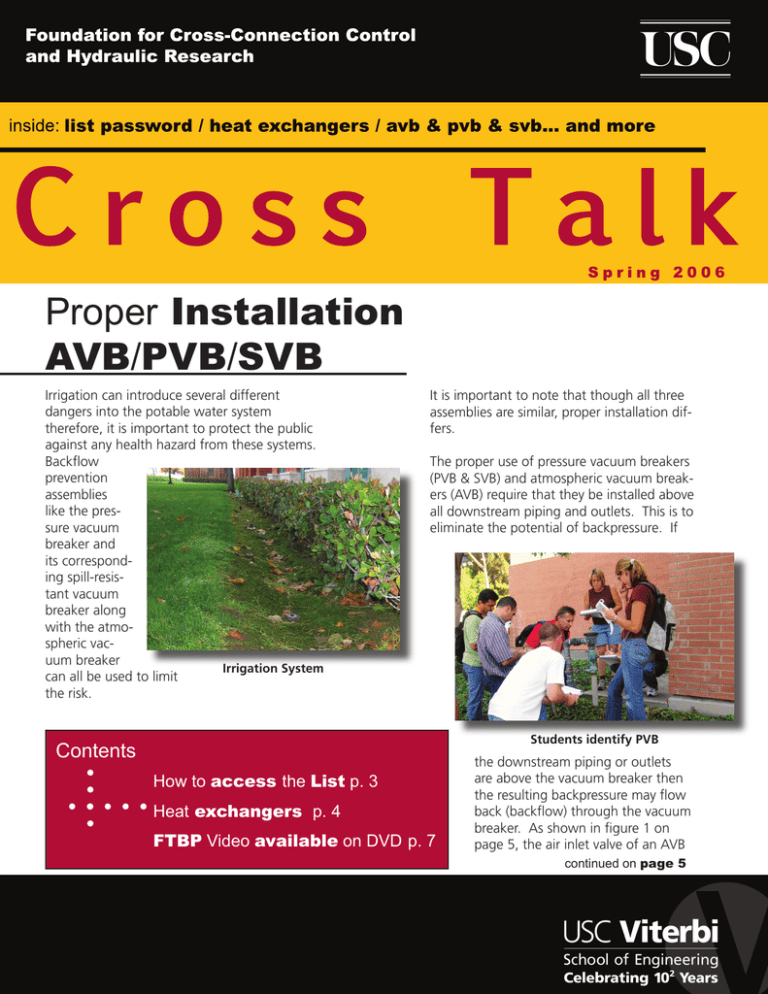
Proper Installation AVB/PVB/SVB Irrigation can introduce several different dangers into the potable water system therefore, it is important to protect the public against any health hazard from these systems. Backflow prevention assemblies like the pressure vacuum breaker and its corresponding spill-resistant vacuum breaker along with the atmospheric vacuum breaker Irrigation System can all be used to limit the risk. It is important to note that though all three assemblies are similar, proper installation differs. The proper use of pressure vacuum breakers (PVB & SVB) and atmospheric vacuum breakers (AVB) require that they be installed above all downstream piping and outlets. This is to eliminate the potential of backpressure. If Students identify PVB Contents How to access the List p. 3 Heat exchangers p. 4 FTBP Video available on DVD p. 7 the downstream piping or outlets are above the vacuum breaker then the resulting backpressure may flow back (backflow) through the vacuum breaker. As shown in figure 1 on page 5, the air inlet valve of an AVB continued on page 5 Foundation Membership The Foundation’s Membership Program provides many benefits. These include: 25% discount on manuals, 20% discount on Foundation Training Courses for any employee of the Member company/ organization, the List of Approved Backflow Prevention Assemblies, printed quarterly, and access to the up-to-the-minute version of the List for those Members with Internet access. Below is a list of those who have become Members of the Foundation this past quarter: SAIC - NV Lawrence Livermore National Laboratory Addison, Town of American Backflow Consulting & Services American Society of Sanitary Engineering American Water Services Inc. Aqua Tech Services City of Asheville McClain Ozone Montezuma Rimrock Water Co. City of Nampa NAVFAC- Washington City of Newport News Olivenhain Municipal Water Dist. Backflow Services Barghausen Consulting Engineer Bob’s Backflow Services Boone, Town of OMI Parker Pacific PIMA Community College Rick Engineering Company Boyle Engineering Corporation Brian West City of Rohnert Park Sacramento Suburban Water District California Dept. of Transportation Campbell University CH2M HILL Scott J. Oliver SJO Consulting Engineers Inc. Slater Plumbing, Inc. Dave’s Mechanical David Herrmann City of Sonoma Standard Contractors, Inc. Delco Sales Thomas Cross Connections Edwards AFB Town of Hillsborough Enbio Audits UCSB Holiday Shores Water Services James E. Sharp, Jr. Joseph Richardson Julie Robinson University of Washington USA Backflow Products Co. City of Vancouver Village of Nakusp Kirkwood Community College La Joya Water Supply Corp. Walsh’s Plumbing & Mechanical Xanterra Parks & Resorts Las Virgenes Municipal Water Dist. Cross Talk SPRING Cross Talk is published by the Foundation for Cross-Connection Control and Hydraulic Research 2006 © University of Southern California. 2006 Page 2 All rights reserved. How to Access the List The List of Approved Backflow Prevention Assemblies has become an essential tool for anyone in the cross-connection control field. Therefore, the Foundation continues to make it readily accessible to all current members of the Foundation. ‘Membership Contact Name’ and ‘E-mail.’ Please note that all the information given must match with the information that the Members of the Foundation can gain access to the List via the Foundation’s website (http://www.usc.edu/fccchr). If you don’t have a password, one may be requested from this website. The benefit for using the Foundation’s website automated password request form is that from that point forward you will be notified of all password and List changes. List of Approved Assemblies Foundation has in its database or the request for a member password will be rejected. It is key that you communicate with the Foundation membership contact to retrieve all the information necessary. Foundation Website Anytime the List is updated you will receive notification via e-mail. Members can go on the Foundation’s website and click on the “Need a Password?” link on the homepage. The moment the link is clicked a pop-up will appear which will request you input the ‘Company’s Name,’ ‘Your Name,’ The List is published in printed format regularly and updated on the Foundation’s website each time a change is made. The List is copyrighted and intended for the use of Foundation members only. Members may use the List as needed for use within the Member’s company, organization, department or agency. However, the List may not be distributed to other entities. In many cases a Member agency needs to pass on the information contained in the List to others as part of the official capacity of the agency. For example, a water agency is a member and requires a customer to install a USC Approved reduced pressure principle assembly (RP). It is permissible in this case for the agency to provide their customer with the data regarding the approved reduced pressure principle assemblies. g Cross Talk SPRING 2006 Page 3 In the Field: Heat Exchangers A heat exchanger is a piece of equipment that is for heating or cooling a medium by transferring energy. When used to heat Heat Exchanger in use domestic water, typically there are two types of heat exchangers: a single-walled heat exchanger and a double-walled heat exchanger. A single-walled heat exchanger uses two areas. Typically, one area would be filled with the heating medium or steam. Running through the steam are tubes with cold domestic water. As the water runs through these tubes, the water heats up and the steam cools down. The cooled steam, or condensate, is returned to the heating source (i.e., boiler) where steam is created and re-circulates through the system. Normally, the steam is chemically treated in order to inhibit corrosion in the steam line. So, the chemically treated steam is separated from the domestic water by the wall of the tube in which the water flows. If this tube should corrode and rupture, then the chemically treated steam may be introduced into the domestic water supply, without any detection. Since a cross-connection could Cross Talk SUMMER2006 2005 SPRING Page44 Page exist, within the single-walled heat exchanger, the domestic water line feeding through the heat exchanger should be protected by appropriate backflow protection, such as a reduced pressure principle backflow prevention assembly. Some chemical additives are considered “essentially nontoxic transfer fluids” having a Gosselin rating of 1. In these cases some administrative authorities have not required backflow protection. However, it should be noted, that there is no guarantee that the same, “non-toxic,” additives will be used in the future. It has been common practice to protect the system assuming that the additive is toxic, even if non-toxic materials were intended. A double-walled heat exchanger is similar to a single-walled heat exchanger, except that the tubes containing the water have two walls, with a path to atmosphere (air-space) in between them. This still allows for the Inside a Heat Exchanger heat to transfer from the heating fluid/steam to the water, but should one of the tube walls rupture, the treated fluid/steam could not get continued on page 6 Proper Installation: AVB/PVB/SVB continued from page 1 will remain closed should backpressure be imposed on the unit This happens because Figure 1 the air inlet valve cannot distinguish between pressure in the normal direction of flow or backpressure. Any pressure on the air inlet valve float will keep it closed tightly against the air inlet seat. If this assembly is subject to backpressure, the air inlet will remain closed, and then it simply operates as a pipe fitting with no potential to prevent backflow. The scenario is the same with the pressure vacuum breaker should the check valve leak. The elevation requirement has been confusing to some people since the AVB must be installed six (6) inches above the downstream piping and outlets, while the requirement for the PVB and SVB is twelve (12) inches. Many people ask why there is a difference. To explain the basis for Pressure Vacuum Breaker this difference, a review of some of the laboratory tests conducted on an AVB, PVB and SVB is needed. In the Foundation’s Manual of Cross-Connection Control, Ninth Edition, Section 10.2.5.3.5 the AVB must undergo a test which entails fouling the check seat with a specifically sized wire, then applying various vacuum conditions to the inlet of the unit. On the outlet of the AVB is a clear tube, which extends down into a vessel of water. See Figure 2. When the various vacuum levels are applied, the water in the clear tube is permitted to rise no more than a maximum of three (3) inches. Should it rise more than three inches, this is cause for rejection. The establishment of the three-inch level was experimentally derived many years ago as a practical level of performance. To provide a safety margin for actual field use, this level was then douFigure 2 bled to six (6) inches. This is the elevation requirement now stated in most codes and regulations for the atmospheric vacuum breaker. The PVB (including the SVB) differs from the AVB in that the PVB or SVB can be used under continuous pressure. The AVB is only designed for non-continuous use (during twelve out of any twentyfour hours). Due to the PVB and SVB being under continuous pressure, the safety factor was increased, requiring the field installation height of twelve (12) inches above all downstream piping and outlets. The PVB and SVB must undergo the same suction-rise test as noted above for the AVB. continued on page 7 Cross Talk SPRING 2006 Page 5 In the Field: Heat Exchangers continued from page 4 into the drinking water system, but would go into the air-filled region. These also are equipped with a “weep hole” in the system, so that any fluid that gets into the air-filled region would discharge through Internals of a Heat Exchanger this weep hole. Not only does this prevent the contaminant from getting into the drinking water supply, but it also acts as a sign to maintenance personnel, that one of the walls is leaking and some corrective measures need to be taken. A listed double-walled heat exchanger is normally identified as not needing additional backflow protection. It should be noted that some heat exchangers might use other mediums besides steam. Those systems that do use steam tend to run at very low pressures (i.e., 10-15 psi), which would minimize the potential for backpressure. However, in a situation where the potable water pressure drops, backflow could easily occur through a leaking single-walled heat exchanger. g Host a Training Course Hosting a Foundation Tester or Specialist course is surprisingly easy and can be advantageous for any Foundation Member. Hosting a course gives any Member the opportunity to have employees involved with cross-connection control and backflow prevention informed about the latest developments in the field. There is no cost for the hosting agency to host a Foundation Training Course. The hosting organization will also receive complimentary registration for two. Registration will be handled directly by the Foundation office. Prior to the announcement of the course, the hosting agency may be asked to recommend local accommodations for those not in the immediate area. Course attendees must submit a registration application along with a purchase order or check; the Foundation will mail a confirmation letter to all course participants. Please visit the Foundation’s website for more information www.usc.edu/fccchr Cross Talk SPRING 2006 Page 6 Proper Installation: AVB/PVB/SVB continued from page 5 In considering the six-inch and twelve-inch elevations, it is also important to know from where the measurements are taken. The critical level (i.e., -CL- or C-L ) of a vacuum breaker may be shown on the outside of the assembly. The critical level normally is at the level of the check valve seat inside the assembly. If the critical level is not marked on the unit, then it is recommended that the bottom of the assembly be used as the reference point. This will ensure that the minimum elevation requirements are maintained. It is also important to note that the elevation requirement is above all downstream piping and outlets. In some older codes wording was used requiring the atmospheric vacuum breaker to be installed above a suitable number of sprinkler heads. The rational was that the water from the higher sprinkler heads would drain out through the lower heads, however, during this draining process the AVB is under backpressure. Current codes use the wording “above all downstream piping and outlets,” or wording to the same effect. This is critical because of the backpressure, which can build up due to the elevation of piping downstream of the assembly. g Field Testing DVD Field Testing Backflow Preventers Instructional Video The Foundation’s Field Testing Backflow Preventers instructional video is one of the more popular and most requested training tools the Foundation has to offer. After exhausting its VHS supply the Foundation has decided to cease production of the tape format and focus solely on a DVD version of the instructional video. The instructional video details the testing procedures as well as troubleshooting for the double check valve assembly, reduced pressure principle assembly and the pressure vacuum breaker assembly. The video follows the procedures outlined in the Manual of Cross-Connection Control, Ninth Edition. All the field testing procedures are accompanied by animation sequences that help the students understand what is happening inside each of the assemblies. An exciting and new feature available only on the DVD version of the instructional video is the “Chapter Select” option; you can now skip to any part of the instructional video and view only the backflow preventer in which you are interested in. Many students find this feature extremely useful and timesaving. The DVD will continue to be made available by the Foundation for the next several months. Once the Manual of Cross-Connection Control, Tenth Edition becomes available a new version of the Field Testing Backflow Preventers instructional video will be created to comply with the field test procedures in the Tenth Edition. Additionally, the spill-resistant vacuum breaker assembly will be included in the next version of the DVD. g Cross Talk SPRING 2006 Page 7 Training Courses Tester Course Los Angeles, CA 10-14 July 2006 Los Angeles, CA 9-13 October 2006 Los Angeles, CA 8-12 January 2007 Specialist Course Los Angeles, CA 24-28 July 2006 Los Angeles, CA 22-26 January 2007 Foundation for Cross-Connection Control and Hydraulic Research University of Southern California Kaprielian Hall 200 Los Angeles, California 90089-2531 Upcoming Events Inland County Backflow Group Seminar San Bernardino, CA 21 September 2006 ABPA Western Regional Backflow Conference •Las Vegas, NV 9-10 October 2006 Western Washington Annual Seminar •Tacoma, WA 18 October 2006 Contact Information Phone: 866-545-6340 Fax: 213-740-8399 E-mail: fccchr@usc.edu Website: www.usc.edu/fccchr First Class US Postage PAID University of Southern California
